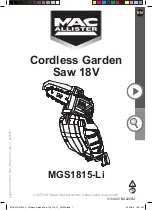
9
For cleaner, safer cuts, set cut depth so that no more than
one blade tooth projects below workpiece. Using proper
cut depth helps to reduce potential for dangerous
KICKBACKS which can cause personal injury.
Bevel cutting (Fig. 11)
Loosen the lever on the bebel scale plate on the front
base. Set for the desired angle (0° - 50°) by tilting
accordingly, then tighten the lever securely.
Sighting (Fig. 12)
For straight cuts, align the A position on the front of the
base with your cutting line. For 45° bevel cuts, align the B
position with it.
Switch action (Fig. 13)
CAUTION:
• Before inserting the battery cartridge into the tool,
always check to see that the switch trigger actuates
properly and returns to the “OFF” position when
released.
• Do not pull the switch trigger hard without pressing the
lock-off lever. This can cause switch breakage.
To prevent the switch trigger from being accidentally
pulled, a lock-off lever is provided. To start the tool, press
the lock-off lever and pull the switch trigger. Release the
switch trigger to stop.
WARNING:
• For your safety, this tool is equipped with lock-off lever
which prevents the tool from unintended starting.
NEVER use the tool if it runs when you simply pull the
switch trigger without pressing the lock-off lever. Return
tool a MAKITA service center for proper repairs
BEFORE further usage.
• NEVER tape down or defeat purpose and function of
lock-off lever.
Lighting the lamp
CAUTION:
• Do not look in the light or see the source of light
directly.
Only to turn on the light, pull the switch trigger without
pressing the lock-off lever.To turn on the light and run the
tool, press the lock-off lever and pull the switch trigger
with the lock-off lever being pressed.
NOTE:
• Use a cotton stick to wipe the dirt off the lens of lamp.
Be careful not to scratch the lens of lamp, or it may
lower the illumination.
• Do not use gasoline, thinner or the like to clean the lens
of lamp. Using such substances will damage the lens.
ASSEMBLY
CAUTION:
• Always be sure that the tool is switched off and the
battery cartridge is removed before carrying out any
work on the tool.
Removing or installing blade (Fig. 14 &
15)
CAUTION:
• Be sure the blade is installed with teeth pointing up at
the front of the tool.
• Use only the Makita wrench to install or remove the
blade.
To remove the blade, press the shaft lock so that the
blade cannot revolve and use the wrench to loosen the
hex bolt counterclockwise. Then remove the hex bolt,
outer flange and blade.
To install the blade, follow the removal procedure in
reverse. BE SURE TO TIGHTEN THE HEX BOLT
CLOCKWISE SECURELY.
(Fig. 16)
When changing blade, make sure to also clean upper and
lower blade guards of accumulated chips and particles.
Such efforts do not, however, replace the need to check
lower guard operation before each use.
Hex wrench storage (Fig. 17)
When not in use, store the hex wrench as shown in the
figure to keep it from being lost.
Connecting a vacuum cleaner (Fig. 18 &
19)
When you wish to perform clean cutting operation,
connect a Makita vacuum cleaner to your tool. Install the
dust nozzle on the tool using the screw. Then connect a
hose of the vacuum cleaner to the dust nozzle as shown
in the figure.
OPERATION
CAUTION:
• Always insert the battery cartridge all the way until it
locks in place. If you can see the red part on the upper
side of the button, it is not locked completely. Insert it
fully until the red part cannot be seen. If not, it may
accidentally fall out of the tool, causing injury to you or
someone around you.
• Be sure to move the tool forward in a straight line
gently. Forcing or twisting the tool will result in
overheating the motor and dangerous kickback,
possibly causing severe injury.
• If the tool is operated continuously until the battery
cartridge has discharged, allow the tool to rest for
15 minutes before proceeding with a fresh battery.
(Fig. 20)
Hold the tool firmly. The tool is provided with both a front
grip and rear handle. Use both to best grasp the tool. If
both hands are holding saw, they cannot be cut by the
blade. Set the base on the workpiece to be cut without the
blade making any contact. Then turn the tool on and wait
until the blade attains full speed. Now simply move the
tool forward over the workpiece surface, keeping it flat
and advancing smoothly until the sawing is completed.
To get clean cuts, keep your sawing line straight and your
speed of advance uniform. If the cut fails to properly follow
your intended cut line, do not attempt to turn or force the
tool back to the cut line. Doing so may bind the blade and
lead to dangerous kickback and possible serious injury.
Release switch, wait for blade to stop and then withdraw
tool. Realign tool on new cut line, and start cut again.
Attempt to avoid positioning which exposes operator to
chips and wood dust being ejected from saw. Use eye
protection to help avoid injury.


































